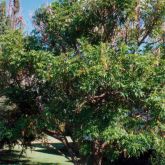Yellow bells

Yellow Bells flowers and leaves
© Queensland Government

Yellow bells inside of pod
© Queensland Government

Yellow bells leaves
© Queensland Government

Yellow bells plant form
© Queensland Government

Yellow bells plant
© Queensland Government

Yellow bells pods
© Queensland Government

Yellowbells flower, leaf and pods
© Queensland Government

Yellow bells leaves, flowers and pods
© Queensland Government
Native to tropical America, yellow bells is a densely branched shrub with yellow flowers. It readily invades native bushland and roadsides.
Yellow bells is a restricted invasive plant under the Biosecurity Act 2014.
Scientific name
Other names
- Tecoma, yellow tecoma
Description
- Shrub 3–8m tall.
- Bark is pale brown to grey, roughens with age.
- Leaves are compound with 2–5 paired leaflets along stem. Each leaflet is up to 10cm long with serrated edges.
- Flowers are bright yellow, 3–5cm long, in clusters at ends of branches.
- Fruit appears as long, bean-like pods, 10–30cm. Pods are green, ripening to brown, and appear in clusters at ends of branches
- Seeds are winged, flat, oblong, 7–8mm long, 4mm wide.
Habitat
- Prefers disturbed areas, grasslands, waterways and along roadsides.
Distribution
- Found in northern and eastern Queensland.
Life cycle
- Flowers during spring and summer.
Impacts
Environmental
- Readily invades native bushland and roadsides.
How it is spread
- Seeds spread by wind, water and suckering.
Prevention
Control
Physical control
- Hand-pull seedlings.
- Do not break taproot if removing by hand as regrowth is likely.
Herbicide control
- Herbicides can be effective.
Biological control
- No known biological control agents.
Legal requirements
- Yellow bells is a restricted invasive plant under the Biosecurity Act 2014.
- It must not be given away, sold, or released into the environment without a permit.
- The Act requires everyone to take all reasonable and practical steps to minimise the risks associated with invasive plants under their control. This is called a general biosecurity obligation (GBO).
- At a local level, each local government must have a biosecurity plan that covers invasive plants in its area. This plan may include actions to be taken on yellow bells. Some of these actions may be required under local laws. Contact your local government for more information.